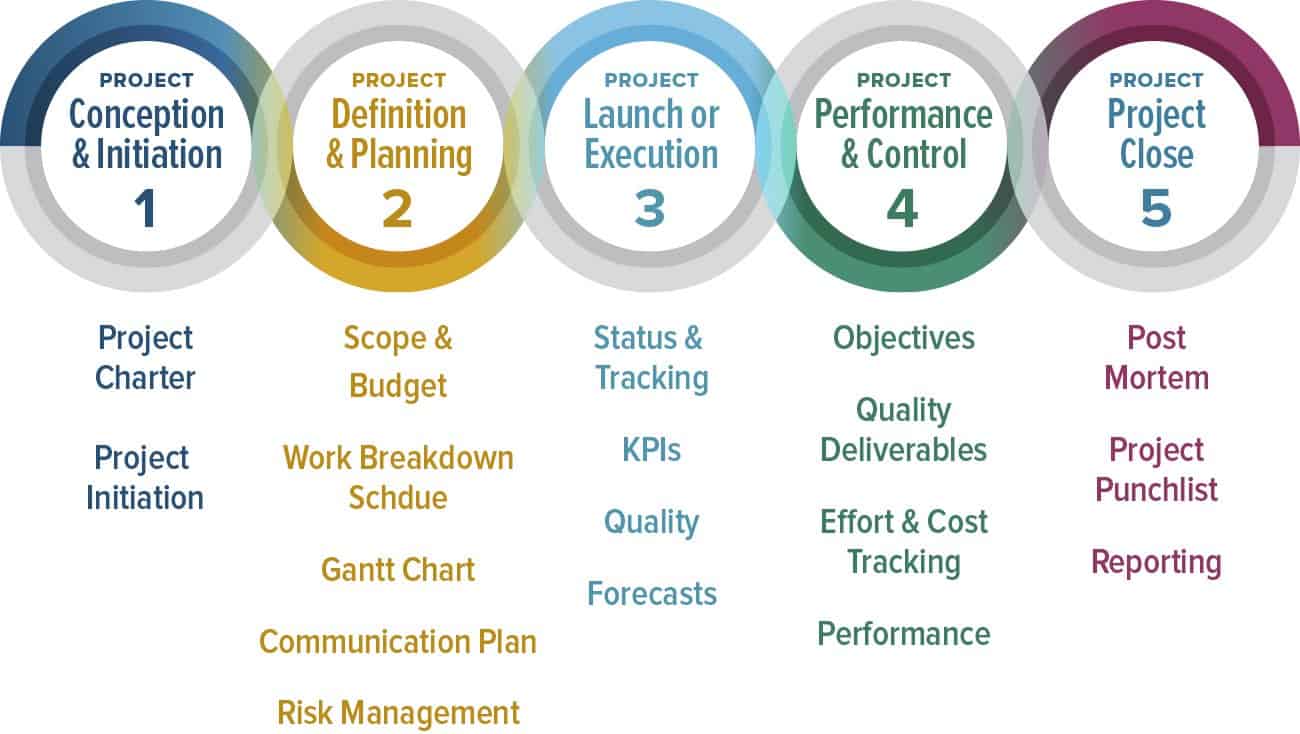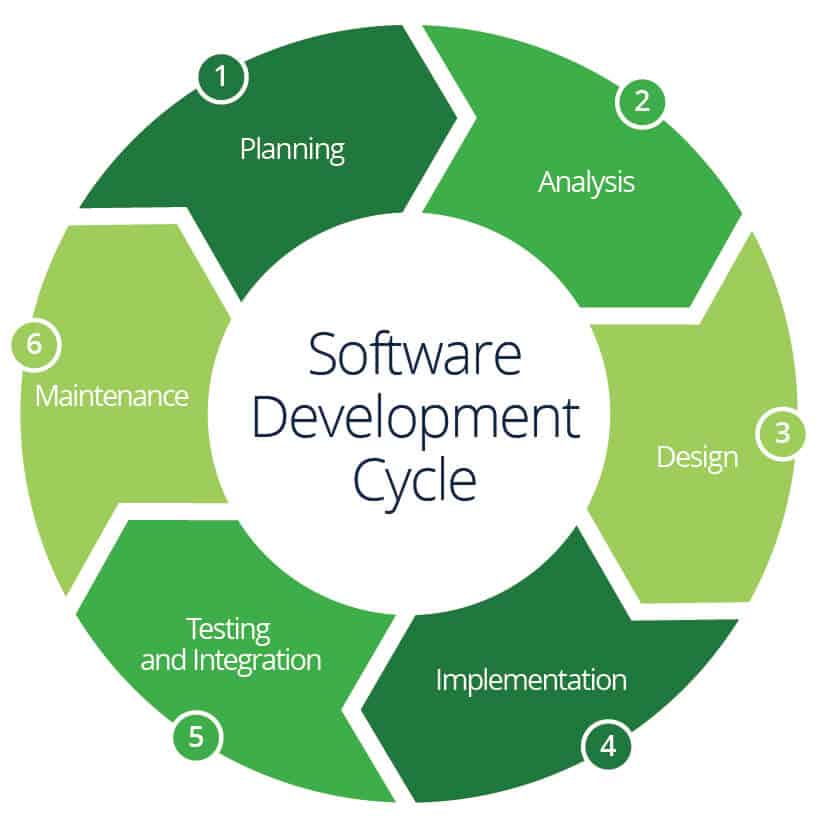What Is Software Project Management?
Developing cutting-edge software is not easy and requires a controlled environment that manages time, resources, people, and costs to ensure on-time, on-budget delivery. The term software project management refers to the planning, scheduling, and organization of a software development project.
Project management dates back to the start of human civilization, but modern project management was born in the early part of the 20th century, when Henry Gantt developed the Gantt chart. Today, project management practices take place across organizations of all sizes and in all industries, including manufacturing, information technology (IT), marketing, finance, and construction. You can find a concise history of project management methodologies here.
John Tukey, a Princeton University statistician, introduced the term “software” in 1958. Initially, companies packaged software as part of the purchase or lease of a computer. In 1969, however, IBM began selling their software as a standalone product, thereby establishing an industry exclusively dedicated to software. As the industry grew, software manufacturers required formalized practices for controlling and releasing software tools. The already-popular project management practices were the perfect fit for managing the lifecycle of software projects.
Project Management Guide
Your one-stop shop for everything project management

Ready to get more out of your project management efforts? Visit our comprehensive project management guide for tips, best practices, and free resources to manage your work more effectively.
Why Is Software Project Management Important?
Project managers have a big responsibility — one that involves much more than avoiding overdue, over-budget software projects. Software project management ensures that the project in question aligns with business goals, achieves high-quality results, and delivers real value to all stakeholders.
Software development comes with multiple risks and challenges — frequent technology changes, immature technology, sloppy development practices, and staff and management turnover, to name a few. Creating software brings other potential challenges as well, such as navigating through stakeholder politics and communicating clearly with end-users, developers, and others. Failure to address such issues can lead to poorly defined system requirements and other problems.
Software project management helps project managers overcome these complexities by inspiring end-user and stakeholder involvement, managing risks, and creating an environment for transparent communication. All of these capabilities help you set realistic project goals, estimate resource requirements more accurately, report on project status, and handle commercial pressures. Software project management offers strategic alignment, leadership, planning, practicality, quality assurance, and proven processes to combat chaos and complexity.
What Are the Types of Software Projects?
Software projects can fall into several categories depending on numerous factors, including the intended use of the software, the type of company developing the software, and the type of end-users. Here are a few of the most common types of software projects:
- New software tools developed by existing software vendors or startups
- Updates, patch fixes, and version releases of an existing software solution
- Mobile applications
- Homegrown, internal support software solutions
The 6 Phases of the Software Development Project Lifecycle
The five phases of project management, developed by the Project Management Institute (PMI), work to standardize project management practices. Each step of the project lifecycle represents the activities necessary to complete the project.
The software development lifecycle (SDLC), a unique software project management lifecycle process, aims to design, develop, and test the quality of software tools. (Note that there are several SDLC models — Agile currently dominates the industry due to its flexibility and fast pace.)
Depending on the methodology you use (e.g., Agile, traditional Waterfall, iterative, v-shaped, spiral, big bang, or a hybrid approach), the phases of software development — also known as software project management stages or steps — you follow may be linear, overlap, repeat, or have varying amounts of focus placed on them. You may find different naming conventions across phases, but the following six steps are the most common designations for the major software development phases:
- Initiation/Planning
- Requirements
- Design
- Build
- Testing
- Implementation
What Is the Software Planning Process?
Planning is the first phase in the SDLC and consists of several activities that set the stage for a successful software development project. Below are the software project planning activities and phases:
- Define the Project Initiative: The project initiative will serve as the software planning roadmap that guides the project. In it, you should do the following:
- Outline project goals.
- Create a baseline.
- Set a budget.
- Create deadlines.
- Identify stakeholders.
- Break Down the Work:
- Host a brainstorming session that includes the entire project team.
- Perform an analysis of past projects.
- Identify all tasks and break them down into subtasks.
- Create a list of all activities and assign them to an individual or group.
- Estimate timelines.
- Create a Resource Schedule:
- Identify resources.
- Evaluate resource constraints.
- Consider outsourcing options.
- Allocate resources.
- Perform Risk Management:
- Identify potential risks and impact.
- Perform qualitative and quantitative risk analyses.
- Create contingency plans.
- Select a Task Management and Communication Platform:
- Identify the required functionality.
- Evaluate products.
- Select a solution.
A project planning template can help you begin mapping out your strategy. The template can be simple or complex, but it should allow for collaboration and real-time adjustments. Click here to download the top project planning templates.
Who Is Involved in Software Project Management?
The responsibilities of software project management — as well as the project results — touch many people and teams across an organization. A software project manager is typically responsible for the management of a project, and developers, engineers, IT, quality assurance (QA), employees from various business departments, contractors, and leadership are also involved at varying stages of the process.
Additionally, clients and customers are involved in the SDLC during user acceptance testing (UAT), which is the final phase of the testing process. During this stage, users (typically clients and customers) put software to the test with real-world test cases to make sure the development is complete.
Software Project Manager Job Duties
Like other types of project managers, a software project manager is the project leader with a diverse set of responsibilities, including project planning, leadership, activity monitoring, time management, budgeting, communication, risk analysis, resource management, and change management. The primary responsibility of the software project manager, though, is to ensure that the team adheres to the SDLC.
If we look at the phases of the SDLC, we can better visualize the many hats worn by the software project manager.
- Initiation/Planning:
- Define the project scope.
- Gather feedback and buy-in from all stakeholders.
- Create a master project plan with the estimates of the project timeline, the schedule, and the total project time. Below are the two major techniques that managers use to make the above estimates:
- Decomposition Techniques: These methods use a breakdown of significant project activities to estimate size, effort, and associated costs.
- Empirical Estimation Techniques: These methods use an educated guess from an expert or group of experts. The techniques base decisions on previous software development projects and apply lines of code (LOC) or function points (FP) in the formula. COCOMO and Putnam are two empirical techniques.
- Divide work into subtasks and relate similar tasks.
- Assign responsibilities based on availability by creating resource requests.
- Create a change control, quality control, communication, and risk management plan.
- Host a project kickoff meeting.
- Estimate project costs, including software, hardware, tools, licenses, human resources, travel expenses, communication needs, training tools, and additional project support.
- Requirements:
- Create a business requirements document.
- Create an implementation plan.
- Design:
- Take an active role in the software design document.
- Build:
- Execute the active development portion of the project.
- Monitor activities and milestones.
- Share status reports with all stakeholders.
- Measure progress and performance along the way.
- Testing:
- Remain informed on user acceptance testing results.
- Ensure the team makes appropriate updates.
- Close project activity.
- Implementation:
- Ensure that all tasks are complete.
- Evaluate project performance.
- Execute the next steps.
Risk analysis and management will take place throughout the entire SDLC. The project manager must have the skills and insight to monitor for, identify, categorize, and manage risks that may occur. If problems arise, they must be able to manage changes (i.e., identify, validate, analyze, control, and execute changes) to reduce or remove risk.
Based on the aforementioned responsibilities of the software project manager, it comes as no surprise that a qualified candidate must possess outstanding multitasking skills. Strong communication and leadership skills, as well as technical acumen, are also vital, along with the ability to pay close attention to detail and remain organized amidst constant change.
Software Project Management Metrics
Each project is subject to unique metrics based on the goals of the business. In other words, all metrics should answer business-related questions. Below are four useful software project management metrics:
- Satisfaction: How satisfied are stakeholders with the project? Similar to a net promoter score, this post-project survey contains a question that calculates the overall satisfaction on a numerical scale.
- Delivery: This refers to the percentage of projects that the team completes on time.
- Cost: This refers to the percentage of projects on which the team stays within budget.
- Defects: This refers to the amount of defects that the team identifies and repairs during the project versus the amount of errors that users report post-implementation.
The Benefits of Software Project Management
Project management can be a significant expense for some organizations, but when software projects involve numerous stakeholders, tasks, and teams — and the results impact customers — the benefits easily outweigh the risks. A project manager can reduce overall expenses by streamlining operations. A project manager has the power to keep a project on time and within budget, but, more importantly, they can create a relationship between internal stakeholders and clients, improving communication and visibility into projects. Additionally, they can reduce risks that negatively impact an organization and minimize the number of issues that can burden software development teams.
Challenges That Impact Software Project Management
Software project management is packed with benefits, but there are potential issues that may arise. These challenges are generally prominent in organizations that attempt to take a cookie-cutter approach, rather than considering each software project individually before applying project management methods. Start by evaluating each project one by one to accommodate unique requirements.
For example, some project management solutions are too expensive for small software development teams. If you purchase a needlessly pricey solution, you risk yielding little return on your investment. Software project management solutions do not have to be costly; spreadsheets and basic solutions are available at minimal expense. And, some software projects may not even require an extensive project management solution. In fact, in the case of a simple project, implementing a complicated solution may do more harm than good. Be sure to consider the type of software projects your team will be managing before investing in a software project management solution.
Tips and Best Practices for Software Project Managers
We have talked about the software development lifecycle and a software project manager’s typical duties, but what are some best practices that contribute to project success? Here are just a few things a project manager can do to build trust and create a high-quality relationship with their team:
- Understand and articulate a company’s needs and goals.
- Gather team feedback.
- Break down a plan into daily tasks.
- Stick to that plan (or make changes only when necessary).
- Share successes to inspire and encourage a team.
Alan Zucker, a project management instructor, advisory consultant, and Founding Principal of Project Management Essentials, recognizes the current communication challenges that project managers face and offers this advice: “Project managers spend nearly 90 percent of their time communicating with team members and stakeholders. The Project Management Institute has researched this subject extensively and supports this statistic. While the most effective form of communication is face to face, many of today’s project teams include remote members. Closing the communication quality gap using an online project management tool can help build relationships and effective collaboration.”
Sergei Brovkin holds an MBA, is a certified PMP, and is a Lean and Six Sigma leader. He echoes the need for excellent communication: “Communication is critical. Set up project meetings from day zero and be sure that they are productive and that everyone attends them. Make sure you fully understand the strategic direction and purpose of the project and be able to explain it clearly.”
In addition to possessing the human-touch elements, software project managers must have technical acumen, be able to separate development from non-development tasks, understand the number and types of users the software tool serves, and have insight into pricing models and deployment methods.
What Software Is Best for Project Management?
Finding the right project management software can be tricky. As mentioned earlier, you must analyze the type of projects you will manage, their complexity and intricacy of detail, your team’s size, and your budget to help you determine the best solution for project success. A software’s features and methods of deployment (in-house versus cloud) are essential considerations. Look at tools that offer Gantt charts, PERT diagrams, resource histograms, and critical path analysis functions. To help you choose the right project management software, read “All about Project Management Software.”
Features to Look for in Software Project Management Tools
A project manager’s workload can quickly become overwhelming. As mentioned in the discussion of the SDLC and project managers’ duties, project managers have a wide variety of responsibilities. But, there are hundreds of software project management tools available to help; they range from individual to mid-sized and high-end systems. To identify the best tool for you, first determine your organization size, the type(s) of software projects you’ll be doing, and which development methodology you’ll be using. Below, you will find features that support the planning, execution, and control of each phase of the SDLC.
- Project estimation
- Scope definition, verification, and control
- Project scheduling/calendar
- Resource management
- Risk management planning and control
- Task management with priorities and categories
- Subtasks
- Budget management and forecasting
- Time and expense management
- Project monitoring and control
- Team collaboration and communication (online discussions and chat, video, and email notifications)
- Kanban boards, Gantt charts, and PERT diagrams
- Milestone tracking
- Document management and file storage
- Analysis, reports, key performance indicators (KPIs), dashboards, and objectives and key results (OKRs), including cost-to-complete analyses
- Permissions and user roles
- Workflow processes
- Portfolio management
- Billing and invoicing
- Mobile apps for iOS and Android
- Easy to use, drag-and-drop configurations and out-of-the-box templates
- Contact management
- Change management
- Configuration management
- Release management
- Artificial intelligence (AI)
- Product roadmaps
- Backlogs/stories
- Subversion
- Bug tracking
- Client portals for communication, UAT, and approvals
The Future of Software Project Management
Emerging technology is revolutionizing every aspect of the technology industry. AI, natural language processing (NLP), and machine learning are already transforming consumer interactions, and it’s only a matter of time before bots are also handling project management activities. Employee expectations are changing, too. Workers now seek flexible, remote work environments, along with the use of personal devices for work purposes (e.g., bring your own device [BYOD]). In many industries, a remote workforce is already the norm.
Project managers are facing the challenge of communicating with a remote workforce, while also having to worry about robots that will take their jobs. Over the next few years, project managers will experience the effects of digital transformation, which will minimize issues that currently cause project delays. Intelligent tools may take on some project management tasks, leaving human project managers to focus on more strategic activities. In addition, technology that improves communication with the increasingly distributed workforce will become the standard. In the near future, companies will have fully adopted and implemented technology and practices that support today’s modern workers. Then, we will move on to the next technological revolution.
Improve Software Development Projects with Smartsheet for Project Management
From simple task management and project planning to complex resource and portfolio management, Smartsheet helps you improve collaboration and increase work velocity -- empowering you to get more done.
The Smartsheet platform makes it easy to plan, capture, manage, and report on work from anywhere, helping your team be more effective and get more done. Report on key metrics and get real-time visibility into work as it happens with roll-up reports, dashboards, and automated workflows built to keep your team connected and informed.
When teams have clarity into the work getting done, there’s no telling how much more they can accomplish in the same amount of time. Try Smartsheet for free, today.



